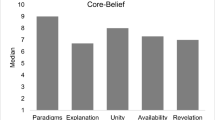Abstract
Recent criticisms of non-reductive accounts of color assume that the only arguments for such accounts are a priori arguments. I put forward a posteriori arguments for a non-reductive account of colors which avoids those criticisms.
Similar content being viewed by others
Notes
As ‘Primitivism’ is commonly used in the color literature, to be a primitivist is to hold only that colors are not reducible to other properties. As such, Primitivism is neutral between Realism and Anti-Realism about colors. Not so here.
The prejudice is aided by the label. Reductive Physicalism, in the color literature, is commonly referred to as “Physicalism.” Primitivism about colors, then, being opposed to what is termed Physicalism, is sometimes taken to be to color what Cartesian Dualism is to the philosophy of mind. Contemporary versions of Primitivism, however, are better compared with non-reductive realism. See Watkins (2005) and Byrne and Hilbert (2007) for more on this point.
Cf. Jonathan Cohen (2004).
My usage of ‘Primitivism’ here is more restricted than is common. Not only do I not include error-theories, I do not include all realists who are commonly treated as primitivists. Colin McGinn (1996), for example, argues that color supervenes on the disposition to look colored. Since, for McGinn, colors are reducible neither to dispositions nor to the physical properties that are the grounds for those dispositions, his account is commonly treated as a version of Primitivism. Since his account does not treat colors as the grounds for those dispositions, McGinn is not a primitivist as ‘Primitivism’ is understood here.
Here I follow Sydney Shoemaker (1998, 2007). It might be thought that there is tension between treating colors as the categorical grounds of dispositions to look colored while individuating properties by the causal powers that they contribute. On my view this tension is the result of confusing the individuating (or identifying) conditions of a property with what that property is. See Watkins (2002, 2005) for more on this distinction.
It might be objected that what I have claimed in defense of Primitivism might be thought compatible with RP. I remind the reader that, at this point, my aim is only to defend Primitivism against certain objections. I am not, yet, attempting to argue for Primitivism against RP. That will come later, in §3.
That this is roughly what Byrne and Hilbert (2007) have in mind is further evidenced by their defining Primitivism as the view that colors are not identical physical properties.
This is perhaps even more explicit in Jackson (1996).
There are reasons, too, to worry that disjunctive accounts fail to locate a unifying feature. For why, see Watkins (2005).
References
Broakes, J. (1997). The autonomy of color, in Byrne and Hilbert 1997a, pp. 191–225.
Byrne, A., & Hilbert, D. (Eds.). (1997a). Readings on color, volume 1: The philosophy of color. Cambridge, MA: MIT Press.
Byrne, A., & Hilbert, D. (1997b). Colors and reflectances, in Byrne and Hilbert 1997a, pp. 263–288.
Byrne, A., & Hilbert, D. (2007). Color primitivism. Erkenntnis, 66, 73–105. doi:10.1007/s10670-006-9028-8.
Campbell, J. (1997). A simple view of color, in Byrne and Hilbert 1997a, pp. 177–190.
Cohen, J. (2004). Color properties and color ascriptions: A relationalist manifesto. The Philosophical Review, 113, 451–506. doi:10.1215/00318108-113-4-451.
Gert, J. (2008). What colors could not be: An argument for color primitivism. Journal of Philosophy, 105, 128–155.
Jackson, F. (1996). The primary quality view of color. Philosophical Perspectives, 10, 199–219.
Kripke, S. (1972). Naming and necessity. Cambridge: Harvard University Press.
McGinn, C. (1996). Another look at color. The Journal of Philosophy, 97, 537–553. doi:10.2307/2941048.
Shoemaker, S. (1998). Causal and metaphysical necessity. Pacific Philosophical Quarterly, 79, 59–77. doi:10.1111/1468-0114.00050.
Shoemaker, S. (2007). Physical realization. Oxford: Oxford University Press.
Smart, J. (1975). On some criticisms of a physicalist theory of colour. In Chung-yin-Chen (Ed.), Philosophical aspects of the mind-body problem (pp. 54–63). Honolulu: University Press of Hawaii.
Watkins, M. (2002). Rediscovering colors. Dordrecht: Kluwer Academic Publishers.
Watkins, M. (2005). Seeing red: The metaphysics of color without the physics. Australasian Journal of Philosophy, 83, 33–52. doi:10.1080/00048400500043936.
Yablo, S. (1995). Singling out properties. Philosophical Perspectives, 9, 477–502. doi:10.2307/2214231.
Acknowledgments
I thank the audiences at those talks for their many helpful comments. I am especially grateful to Justin Broakes, Alex Byrne, Joshua Gert, David Hilbert, Sydney Shoemaker, Louise Antony, Boran Bercic, Jody Graham, Kelly Jolley, Duncan MacIntosh, Sheldon Wein, and Richmond Campbell. I also thank an anonymous referee for several helpful comments.
Author information
Authors and Affiliations
Corresponding author
Additional information
Versions of this paper were read at a conference on color at Florida State University, the Metaphysics and Epistemology Conference in Dubrovnik, the Dalhousie University Philosophy Department, and the Auburn University Philosophy Department.
Rights and permissions
About this article
Cite this article
Watkins, M. A posteriori primitivism. Philos Stud 150, 123–137 (2010). https://doi.org/10.1007/s11098-009-9394-6
Received:
Accepted:
Published:
Issue Date:
DOI: https://doi.org/10.1007/s11098-009-9394-6




